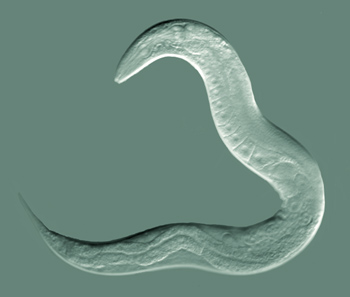Teaching the Cutting Edge: Martin Chalfie
The Nobel Prize-winning Columbia University professor offers guidance on how to be a more effective science teacher.
Published September 27, 2010
By Academy Contributor

On September 22, 2010, Martin Chalfie kicked off the Academy’s Teaching the Cutting Edge series, designed to connect top scientific researchers to science teachers. Chalfie outlined how his research on nerve cell development in the model organism C. elegans, a small translucent nematode, led to his Nobel Prize-winning discovery on the use of green fluorescent protein (GFP). This now standard technique in biology classrooms revolutionized our ability to see and explore the inner workings of cells.
Chalfie’s life’s work explores nerve cell development using C. elegans. Chalfie and his team investigate how mutations in the worms’ genomes can lead to varying degrees of touch sensitivity in the worms’ simple nervous systems. Prior to the use of GFP, only a few highly flawed methods existed for understanding gene and protein expression, but Chalfie saw promise in the combination of the gene for a glow-in-the-dark protein and a translucent worm.
Studying Touch Sensitivity
The GFP gene could be used to show which cells express a particular worm gene by using the worm gene’s regulatory sequence to direct GFP production. Thus the fluorescing protein would appear in all the places in the worm’s body where the gene’s products would ordinarily have appeared. Chalfie used this method to study touch sensitivity, identifying the neurons that expressed the genes involved in touch sensation and examining where in the cell the gene products were located. Identifying where these genes were active was the necessary first step to discovering the molecules that allow the cells to respond to touch.
In addition to describing the scientific process that led to the discovery and use of GFP, Chalfie outlined myths that are often taught to children about science and scientists, providing teachers with an excellent resource to explore the Nature of Science and the truth about those who practice it. Chalfie framed the process of science not as a lone genius in a sterile room, but as a network of hard-working, creative, and clever scientists putting the pieces together over time.
Collaboration and the Scientific Process
Chalfie is the William R. Kenan Jr. Professor of Biological Sciences at Columbia University and former Chair of the Biological Sciences Department. He shared the 2008 Nobel Prize in Chemistry with Osamu Shimomura and Roger Y. Tsien for the “discovery and development of green fluorescent protein.” Shimomura first isolated GFP from a jellyfish and discovered that the protein glowed bright green under ultraviolet light.
Chalfie showed that GFP could be produced in other organisms and be fluorescent without any added cofactor. His findings meant that GFP could be used to light up proteins, cells, and organisms. And Tsien extended the color palette, giving scientists the ability to tag various proteins and cells with different colors and study several different biological processes at the same time. Chalfie, Shimomura, and Tsien all contributed to the success and durability of each other’s work—their collaborations, intentional and not, were crucial to their scientific process.
This content is aimed at high school level biology and chemistry teachers and focuses on the following concepts:
- Cells and cellular structures with an emphasis on nerve cell development
- Genetics and genetic expression with an emphasis on mutations and genetic engineering
- Chemical reactions and configurations of atoms, specifically proteins
- Technologies that allow us to better visualize scientific phenomena and how those advances can lead to revolutions in a scientific field
- The Nature of Science and how scientific questions and collaborations guide the development of new techniques and advances
- Non-traditional career paths in science
While Chalfie’s talk was aimed at teachers, it was also very much enjoyed by the high school and college students and members of the general public in the audience.
Also read: Good Teachers Yield Promising Returns for Confident Students
